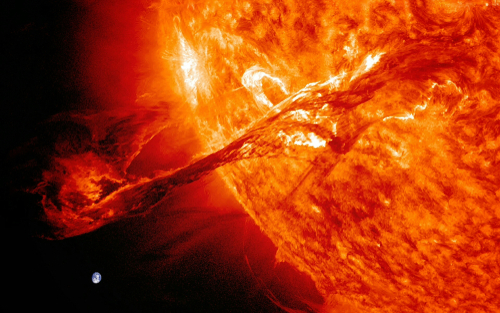No, a Massive Geomagnetic Storm Will Not Hit Earth on March 18
Some media outlets have reported that Earth is expecting a “massive magnetic storm” on March 18. That’s wrong, according to the National Oceanic and Atmospheric Administration (NOAA). And they would know: Not only does NOAA help people build forecasts for weather here on Earth, they also predict space weather events like geomagnetic storms.
“This story is not plausible in any way, shape or form,” Bob Rutledge, who leads NOAA’s Space Weather Forecast Center, told Newsweek via e-mail. “Things are all quiet for space weather, and the sun is essentially spotless.”
The magnetic storm’s “imminent” arrival was one of Monday morning’s top science news stories, according to Google News. But most coverage appeared to be based on a misinterpretation of a chart posted on Russia’s Lebedev Institute’s website showing a minor uptick in geomagnetic activity on the 18th. That elevated activity is expected to be a minor storm at most. (NOAA’s forecast shows similar readings.)
Geomagnetic storms are rated on a scale of G1 to G5, with G5 being the most extreme. On the 18th, readings will likely just reach the threshold for a G1—a minor—geomagnetic storm. G1 storms happen frequently, about 2,000 times every 11 years, or once every two days.
This scale is based in part on an index created from the amount of magnetic deviation a storm might produce on the ground combined with measurements of a variety of currents with fabulous names, including the “auroral electrojets” and the “field-aligned current.” The measurement of another type of current is called the “disturbance storm time index,” according to NOAA’s website.
A massive geomagnetic storm would be a really big deal. A powerful magnetic storm could cause blackouts and damage communications satellites. According to the federal government’s Ready.gov website, one geomagnetic storm in 1859 shocked telegraph operators and set the paper they were working with on fire, while another in 1989 caused a nine-hour blackout in Canada.
If you’re unconvinced that everything is going to be fine on March 18, the Ready.gov website has some tips. Preparing for a major space weather event is a lot like preparing for other kinds of natural disasters. Be sure to have fresh water on hand, gas in your car’s tank and copies of any important documents or information you might need.
And if you’re going to get space weather predictions from somewhere, get them from a scientific authority—not someone on YouTube—and double-check the legends. Just a suggestion.
This article was updated to include more information about how the severity of a geomagnetic storm is rated.

